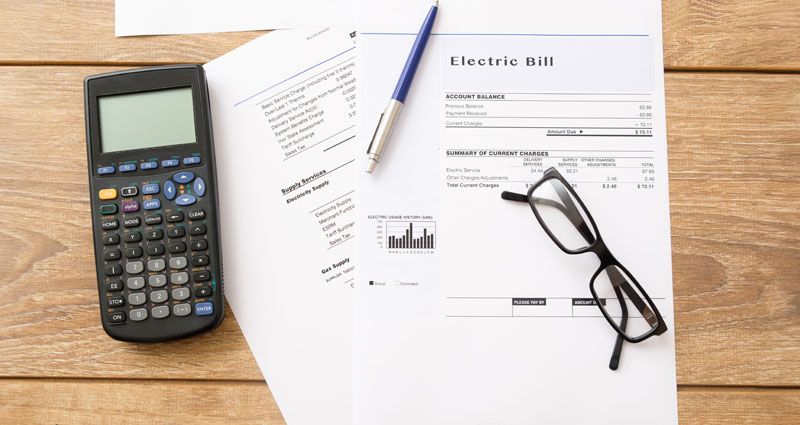Electricity choice is great, but comparing one plan or one electricity company to another can sometimes take work. For this reason, the Public Utility Commission of Texas (PUC) requires all Retail Electricity Providers (REPs) in Texas to provide an Electricity Facts Label for each plan they sell for transparency so that consumers are equipped with the resources they need to find the plan and provider that's right for them. We want to make sure that customers have all the information necessary to answer questions like:
- How much will I be charged for the electricity I use?
- Does this plan come with a contract?
- How long is the contract for this plan?
- Is there a fee if I break the contract?
- What else will I be charged by this electricity company?
- Is this a fixed-rate plan or a variable-rate plan?
While an Electricity Facts Label offers a useful and structured way to compare plans across companies, it can take time to decipher what all that information means. We'll take the mystery out of it so you'll know what information to expect, how to read an Electricity Facts Label, and how a document can help you choose the electricity plan that is right for you. And EFL will include the following:
Electricity price charges
This area shows the price of the plan, including the energy rate per kilowatt-hour (kWh), base charge, and delivery charges.
Kilowatt-hour (kWh)
This unit of measures electricity usage — most electricity plans charge based on a rate per kWh.
Energy charge
The energy charge is the price you'll pay for each kWh you use. This price is set by the retail energy provider (REP).
Base charge
The base charge is a fixed monthly fee that helps cover the operational costs of providing you with energy service.
TDU charges
The Transmission and Distribution Utility (TDU) delivery charges also help cover the cost of delivering electricity to your home. These charges are set by your local utility and are the same for every REP that services the area. TDU charges include a usage-based (per kWh) and a fixed (per month) component. On the Direct Energy EFLs, these charges are associated with the name of your local utility: CenterPoint, Oncor, AEP North, AEP Central, or Texas New Mexico Power.
Average price per kWh
At the top of every EFL is a chart listing the average monthly usage price of 500, 1,000 and 2,000 kWh. The prices listed here factor in all the charges you see on the EFL, giving you a better idea of your total per-kWh price based on your usage. These rates vary based on usage because fixed charges are divided by the number of kWh.
The best way to use this chart is to compare your usual usage to the averages listed. You can find it on your past electric bills if you don't know your usage. As the chart indicates, the average electricity price can vary monthly based on how much energy you use.
How to calculate the average energy price
Energy Charge + Per-kWh TDU Fee + [(Per-month TDU charge + Base Charge)/Usage]
Here is the calculation step by step:
- Add the energy charge per kWh and the per-kWh TDU delivery charge together.
- Add the base charge and the per-month TDU delivery charge. Divide this by the number of kWh used.
- Add the numbers from steps 1 and 2 to get the average price per kWh.
Let's walk through an example.
- Usage: 500 kWh
- Energy charge: 7 cents per kWh
- Base charge: $5.00
- Per-month TDU delivery charge: $5.00
- Per kWh TDU delivery charge: 4 cents per kWh
Here's how to calculate the energy price for an average usage of 500 kWh:
$0.07 + $0.04 + [($5+ $5)/500 kWh] = 13 cents per kWh
Special rates
Some plans, such as our free weekend and night plans, offer a special pricing structure different from regular plans. To ensure customers understand exactly what they're paying for, these plans reflect a slightly different layout on their EFLs.
The most significant difference is that you will see two rates on the "energy charge" line — one for your free hours (0 cents) and one for the rest of the time. Just like regular plans, the chart will factor in every charge listed below it to give you the average rate at those usage points.
Other key terms and questions
"Other Key Terms and Questions" will explain the average price detailed in section one and encourage you to read the Terms of Service statement for the REP providing this plan. This area outlines:
- The plan type is usually fixed-rate or variable. You'll also see a line item for whether or not the product is pre-pay or pay-in-advance.
- The contract term length is usually from 1 to 36 months. Month-to-month contracts will be listed as 1-month.
- The termination fee amount is charged if you terminate your contract before the specified term length.
- Whether or not your price can change during your contract period. The "price" here refers to the total price that includes the energy charge, base charge, and delivery charges.
- How the price can change, and by how much. Price changes usually come from updates in charges and fees from your TDU or governing agencies. These types of updates are not controlled by REPs.
- Other fees that might be associated with your electricity bill are usually non-recurring fees listed as a separate line item on your bill.
Renewable energy
This section addresses the renewable energy operations of the REP and the renewable content of the product.
- Distributed renewable generation is when individual homes or businesses produce renewable energy. This area tells you whether the REP buys the excess energy they produce.
- Renewable energy percentage and statewide average outlines the percentage of renewable energy content associated with the plan based on the REP's purchase of Renewable Energy Certificates, compared to the Texas average for renewable content.
Quick tips on shopping for a plan
Think about total cost
When shopping for energy plans, it's important to think about the total monthly cost. We make it easy to calculate your average rate and your total estimated electricity cost with our bill estimator. When you shop our plans, just click "Plan Details" and you can view your estimated total charges and average rate for the three usage levels listed on the Electricity Facts Label and
Use the energy charge to compare prices
The only charge that will vary among different plans is the energy charge. Our base charge is the same for each plan, and the TDU delivery charges from your local utility are also standard for every plan. So when you're comparing prices, all you need to know is the energy charge.
It would help if you always ask for an Electricity Facts Label for any electricity plan you're considering, and the REP should always give it to you. With this information, you can have an "apples to apples" comparison between electricity plans and companies so that you can make an informed decision as you shop for the Texas electricity company that best meets the needs of your home. By understanding all the information presented on an Electricity Facts Label, you will better understand how the Texas electricity market works.


































